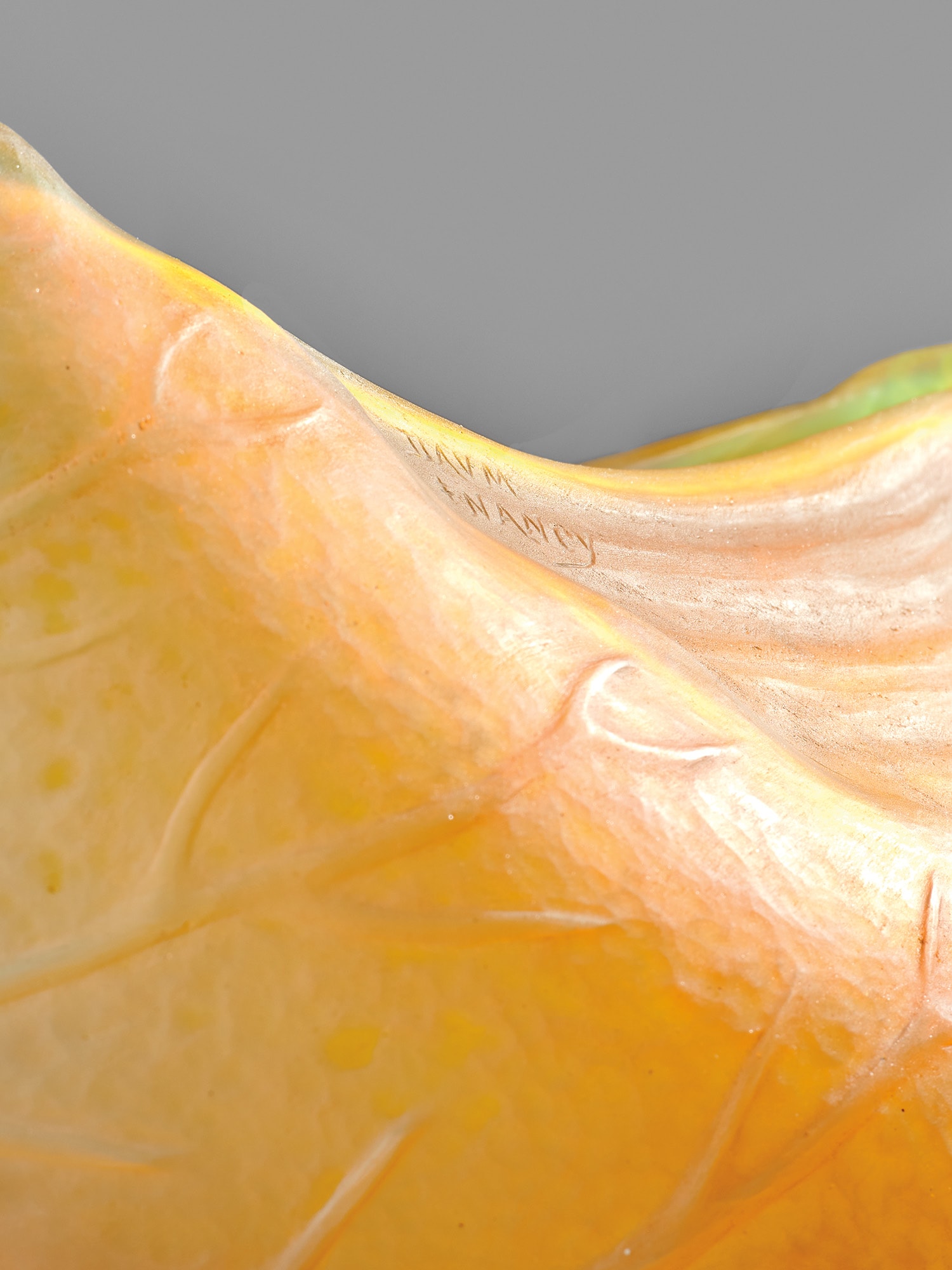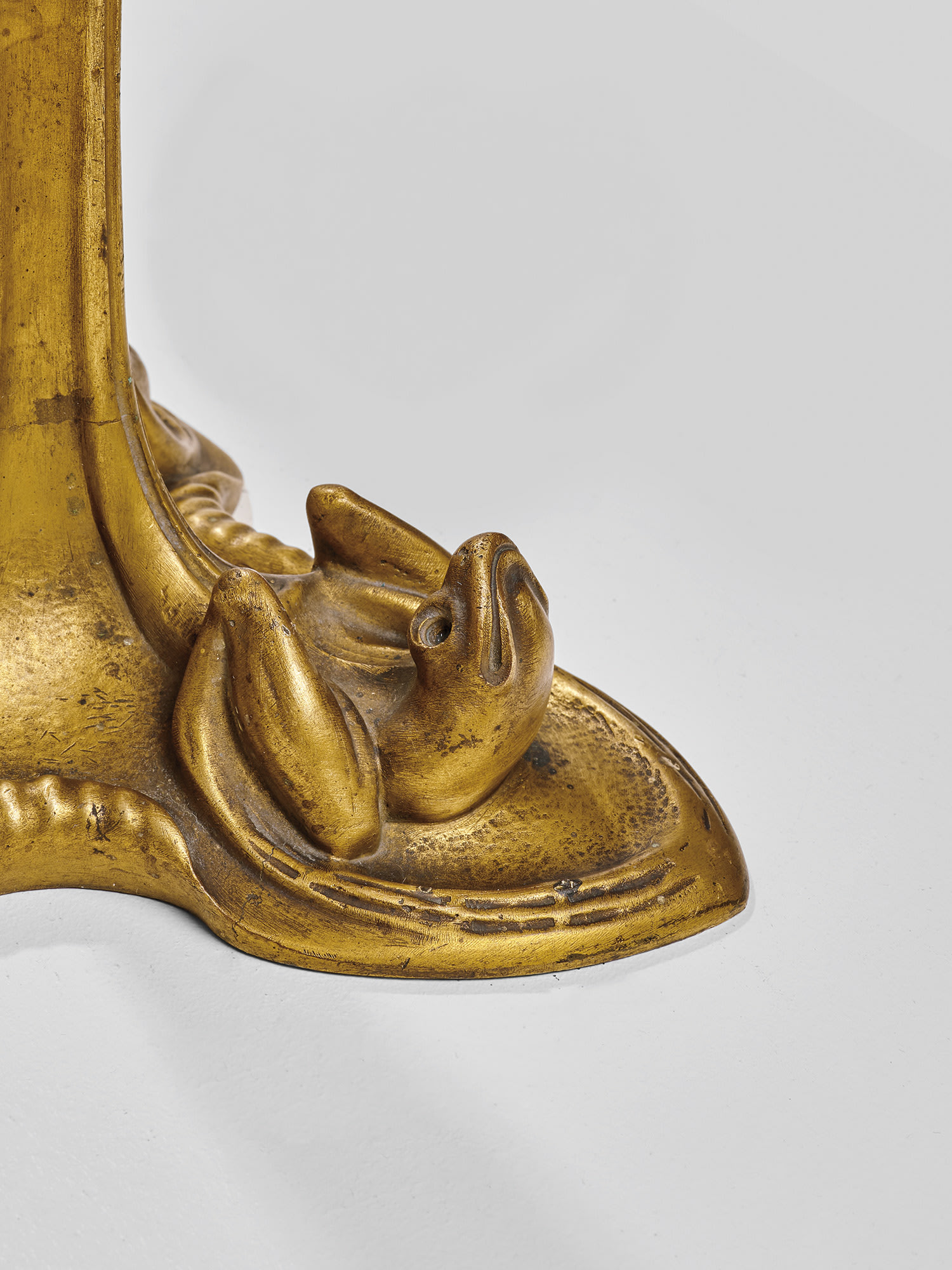









40
Daum Frères and Louis Majorelle
'Nénuphar' table lamp
circa 1903
Patinated bronze, dichroic glass.
68 cm (26 3/4 in.) high, 27 cm (10 5/8 in.) diameter
Glass produced by Daum, Nancy, France and base produced by Louis Majorelle, Nancy, France. Glass acid-etched Daum/‡ Nancy.
Full-Cataloguing
Defining the Art Nouveau: Majorelle and Daum's 'Nénuphar' Table Lamp
By Dr. Margaret J. Schmitz
During an age of rampant industrialisation, the Art Nouveau’s references to motifs plucked directly from nature offered respite to those concerned with modernity’s encroachment on all aspects of life. The style was established in Belgium and France and peaked in popularity around 1900 when the Exposition Universelle in Paris disseminated it to a broader public. Its sinuous, flowing lines and whip-lash curves radically challenged conventional historicist tastes at the time. Like the Arts and Crafts Movement and Gothic Revival designers before them, followers of the Art Nouveau embraced the idea of ‘total design’: a notion that all decoration and aspects of a work must be in harmony with the space around it. Architecture, furniture and lighting all seemed to burst with fertile vegetal forms, resulting in cohesive, lush interiors. Art Nouveau designers utilised a variety of media to achieve these alchemic effects and when they didn’t have the appropriate expertise in house collaboration was the logical result. Louis Majorelle and Daum Frères’s 'Nénuphar' table lamp is both an archetype of the movement and also a consequence of the period’s most celebrated design partnership.
Around 1890, the French furniture designer Majorelle added a metalwork atelier to his factory. Initially, his bronze, copper, and wrought iron elements ornamented desks, chairs, beds, and tables, but soon the rise of electricity offered new opportunities for lighting. Majorelle realised the aesthetic potential of this technology and wisely began to collaborate with the renowned glass manufacturer Daum Frères around 1891. While Daum had several metalwork designers in close proximity to the firm’s Nancy studio it was Majorelle’s elegant, fecund forms and attention to detail that attracted the Maison. The two firms went on to co-design several objects that provided them with mutual creative satisfaction and commercial gain while categorically defining the Art Nouveau’s aesthetic. There are no records indicating which of the two design houses created the initial visualisations of their products. But it is evident that intense artistic and technical collaboration occurred as both firms worked to seamlessly integrate their respective materials and transmute them into ecological illusions of dynamic proportion.
Majorelle and Daum showed their first versions of the famed 'Nénuphar' (Waterlily) lamp at the Salon des Artistes Français in 1902. The following year, samples of their table lamps were presented during the Exposition de l'Ecole de Nancy at the Pavillon de Marsan. The present lot was completed around this time, likely in 1903, when the two firms had honed the form. The lamp’s hollow patinated bronze ‘stem’, within which an electrical wire is concealed, appears to sprout from the ground. Its base boasts a triad of frogs whose faces and attenuated joints are turned defiantly upward, coaxing the viewer’s eye to ascend along the lamp’s form toward a dichroic glass shade, which bulges sensuously out between three bronze leaves that cradle it. The entire design effectively metamorphoses industrial materials of metal and glass into a slender waterlily. The glass shade, expertly molded into the bulbous shape of a bloom, transitions from rich amber tones to translucent ochres with subtle blushes of green. The illusion is made complete with the addition of delicate veining seen throughout its petals. Because Majorelle and Daum utilised opalescent shades on their lamps, much of the light emitting from them was rarely above a soft glow. Therefore, the 'Nénuphar' lamp was primarily collected as an artistic object that provided ambient light. Indeed, these objects were made to chiefly illuminate themselves from within. The result is a soft tonal fantasy that presents an otherworldly version of nature perfected.
Other versions of this lamp were produced. This was in keeping with Majorelle and Daums’s principles regarding industrial production in the service of providing art for all. However, each of the 'Nénuphar' lamps are a unique testament to the pair’s technical talent, versatility, and imagination. For instance, the bronze base found on a version at MoMA is gilt and patinated while a version at the Musée d'Orsay is absent of the present work’s charming amphibians and its shade’s more sumptuous colour. As evidenced by these other versions and the current table lamp offered for sale, each creation by Majorelle and Daum is not just a rare, but rather a singular reflection of their ingenuity.
Contemporary life is not so different from the Art Nouveau’s historical context. Human beings are still routinely alienated from nature, which makes the present lot’s effect evermore poignant. The lamp’s emotional impact is that the exterior, natural world (largely excluded from the tight-knit urban fabric of our modern cities) is now brought inside. With its soothing hues of green and amber, as well as its attenuated floral silhouette, the 'Nénuphar' table lamp provides a reprieve from the bustling noise of modernity’s ceaseless thirst for industrial advancement—just as it did over a century ago.
By Dr. Margaret J. Schmitz
During an age of rampant industrialisation, the Art Nouveau’s references to motifs plucked directly from nature offered respite to those concerned with modernity’s encroachment on all aspects of life. The style was established in Belgium and France and peaked in popularity around 1900 when the Exposition Universelle in Paris disseminated it to a broader public. Its sinuous, flowing lines and whip-lash curves radically challenged conventional historicist tastes at the time. Like the Arts and Crafts Movement and Gothic Revival designers before them, followers of the Art Nouveau embraced the idea of ‘total design’: a notion that all decoration and aspects of a work must be in harmony with the space around it. Architecture, furniture and lighting all seemed to burst with fertile vegetal forms, resulting in cohesive, lush interiors. Art Nouveau designers utilised a variety of media to achieve these alchemic effects and when they didn’t have the appropriate expertise in house collaboration was the logical result. Louis Majorelle and Daum Frères’s 'Nénuphar' table lamp is both an archetype of the movement and also a consequence of the period’s most celebrated design partnership.
Around 1890, the French furniture designer Majorelle added a metalwork atelier to his factory. Initially, his bronze, copper, and wrought iron elements ornamented desks, chairs, beds, and tables, but soon the rise of electricity offered new opportunities for lighting. Majorelle realised the aesthetic potential of this technology and wisely began to collaborate with the renowned glass manufacturer Daum Frères around 1891. While Daum had several metalwork designers in close proximity to the firm’s Nancy studio it was Majorelle’s elegant, fecund forms and attention to detail that attracted the Maison. The two firms went on to co-design several objects that provided them with mutual creative satisfaction and commercial gain while categorically defining the Art Nouveau’s aesthetic. There are no records indicating which of the two design houses created the initial visualisations of their products. But it is evident that intense artistic and technical collaboration occurred as both firms worked to seamlessly integrate their respective materials and transmute them into ecological illusions of dynamic proportion.
Majorelle and Daum showed their first versions of the famed 'Nénuphar' (Waterlily) lamp at the Salon des Artistes Français in 1902. The following year, samples of their table lamps were presented during the Exposition de l'Ecole de Nancy at the Pavillon de Marsan. The present lot was completed around this time, likely in 1903, when the two firms had honed the form. The lamp’s hollow patinated bronze ‘stem’, within which an electrical wire is concealed, appears to sprout from the ground. Its base boasts a triad of frogs whose faces and attenuated joints are turned defiantly upward, coaxing the viewer’s eye to ascend along the lamp’s form toward a dichroic glass shade, which bulges sensuously out between three bronze leaves that cradle it. The entire design effectively metamorphoses industrial materials of metal and glass into a slender waterlily. The glass shade, expertly molded into the bulbous shape of a bloom, transitions from rich amber tones to translucent ochres with subtle blushes of green. The illusion is made complete with the addition of delicate veining seen throughout its petals. Because Majorelle and Daum utilised opalescent shades on their lamps, much of the light emitting from them was rarely above a soft glow. Therefore, the 'Nénuphar' lamp was primarily collected as an artistic object that provided ambient light. Indeed, these objects were made to chiefly illuminate themselves from within. The result is a soft tonal fantasy that presents an otherworldly version of nature perfected.
Other versions of this lamp were produced. This was in keeping with Majorelle and Daums’s principles regarding industrial production in the service of providing art for all. However, each of the 'Nénuphar' lamps are a unique testament to the pair’s technical talent, versatility, and imagination. For instance, the bronze base found on a version at MoMA is gilt and patinated while a version at the Musée d'Orsay is absent of the present work’s charming amphibians and its shade’s more sumptuous colour. As evidenced by these other versions and the current table lamp offered for sale, each creation by Majorelle and Daum is not just a rare, but rather a singular reflection of their ingenuity.
Contemporary life is not so different from the Art Nouveau’s historical context. Human beings are still routinely alienated from nature, which makes the present lot’s effect evermore poignant. The lamp’s emotional impact is that the exterior, natural world (largely excluded from the tight-knit urban fabric of our modern cities) is now brought inside. With its soothing hues of green and amber, as well as its attenuated floral silhouette, the 'Nénuphar' table lamp provides a reprieve from the bustling noise of modernity’s ceaseless thirst for industrial advancement—just as it did over a century ago.